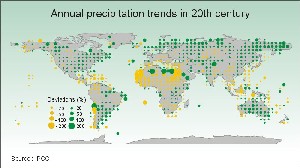 > ENC Master > Climate Encyclopaedia > People changing climate > more > 1. Man-made climate change? > * Worksheet 2
> ENC Master > Climate Encyclopaedia > People changing climate > more > 1. Man-made climate change? > * Worksheet 2
 |
|
|
|
|
||
|
people changing the climate? |
1. Man-made climate change?
Worksheet 2
|
|
b) Look at this diagram - it shows precipitation (rain and snow) changes during the last 100 years in different areas of the globe. Where has precipitation increased the most? Where has it decreased the most? Were these places particularly wet or dry before the change? What connections can you see between this map and the map in a? What consequences do you think the changes may have in the most affected places? |
2. Experiment: Gases dissolved in waterPour soda water in two test tubes. Put one in a hot bath (hot tap water) and the other in a cold bath. Watch what happens in each of the tubes. Can you explain what you observe? Can you use your observations to explain what will happen to the CO2 dissolved in sea water if the sea warms up? |
|
|
|



